Cifford Clark is a recent retiree who is interested in investing some of his savings in corporate bonds. His financial planner has suggested the following bonds: - Bond A has a 9% annual coupon, matures in 12 years, and has a $1,000 face value. - Bond B has an 11% annual coupon, matures in 12 years, and has a $1,000 face value. - Bond C has a 10% annual coupon, matures in 12 years, and has a $1,000 face value. Each bond has a yield to maturity of 10% The data has been collected in the Microsoft Excel file below, Download the spreadsheet and perform the required analysis to answer the questions below Do not round intermediate calculations. Use a minus sign to enter negative values, if any. If an answer is zero, enter " 0 ". Download spreadsheet Bond Valuation-f99ane x isx d. Before catcutating the prices of the bonds, indicate whether each bond is trading at a premium, at a discount, or at par. b. Calculate the price of each of the thee bonds, Round vear answers to the nearest cent. Price(BondA)4Price(BendB)isPrice(BendC)is c. Calculate the current yeld for each of the three bonds. (Hint: The expected carrent yield is calculated as the annual interest evided by the price of the bond.) Round your answers to two decimal places. Current yield (bond A): Curtent yield (thond B ) : Current yield (Bond C): cent. Brice (hand A) is frice coond bits mine thand chis Price (Bond Clis: What is the expected capital gains yield for each bond? What is the expected total return for each bond? Round your answers to treo decimal places. E E e. Mr. Clark is considering another bond, Bond D. It has a 95 semiannubl coupon and a $1,000 face value (iec.u is pays a $45 coupon everr 6 months) Bond D is scheduled to mature in 8 vears and has a price of $1,170. It is also callable in 6 vears at a call price of $1,030. 1. What is the bonds nominal yeld to maturity? lusund your answer to two decimal places. 2. What is the bond's nemunar yield to call? Round vour ansner to two decimal places. Becavse the YTM is f. Explain brefly the difference between price risk and reinvestment risk: This rak of a decine in bond values due to an increase in interest rates is talled The risk of an income decine due to a Cifford Clark is a recent retiree who is interested in investing some of his savings in corporate bonds. His financial planner has suggested the following bonds: - Bond A has a 9% annual coupon, matures in 12 years, and has a $1,000 face value. - Bond B has an 11% annual coupon, matures in 12 years, and has a $1,000 face value. - Bond C has a 10% annual coupon, matures in 12 years, and has a $1,000 face value. Each bond has a yield to maturity of 10% The data has been collected in the Microsoft Excel file below, Download the spreadsheet and perform the required analysis to answer the questions below Do not round intermediate calculations. Use a minus sign to enter negative values, if any. If an answer is zero, enter " 0 ". Download spreadsheet Bond Valuation-f99ane x isx d. Before catcutating the prices of the bonds, indicate whether each bond is trading at a premium, at a discount, or at par. b. Calculate the price of each of the thee bonds, Round vear answers to the nearest cent. Price(BondA)4Price(BendB)isPrice(BendC)is c. Calculate the current yeld for each of the three bonds. (Hint: The expected carrent yield is calculated as the annual interest evided by the price of the bond.) Round your answers to two decimal places. Current yield (bond A): Curtent yield (thond B ) : Current yield (Bond C): cent. Brice (hand A) is frice coond bits mine thand chis Price (Bond Clis: What is the expected capital gains yield for each bond? What is the expected total return for each bond? Round your answers to treo decimal places. E E e. Mr. Clark is considering another bond, Bond D. It has a 95 semiannubl coupon and a $1,000 face value (iec.u is pays a $45 coupon everr 6 months) Bond D is scheduled to mature in 8 vears and has a price of $1,170. It is also callable in 6 vears at a call price of $1,030. 1. What is the bonds nominal yeld to maturity? lusund your answer to two decimal places. 2. What is the bond's nemunar yield to call? Round vour ansner to two decimal places. Becavse the YTM is f. Explain brefly the difference between price risk and reinvestment risk: This rak of a decine in bond values due to an increase in interest rates is talled The risk of an income decine due to a









